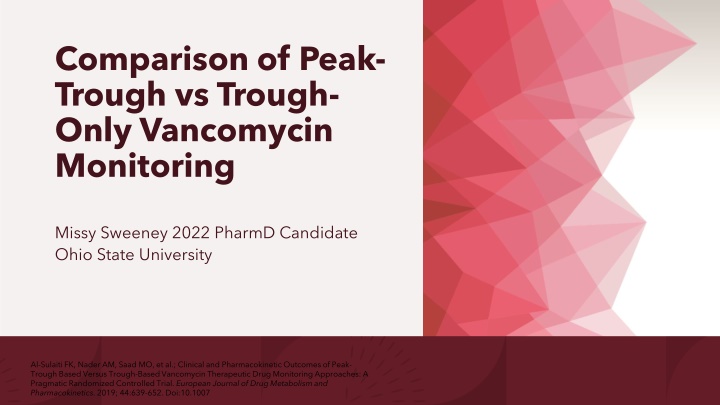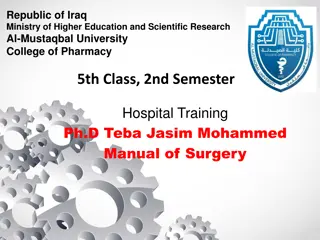
Comparison of Peak-Trough vs Trough-Only Vancomycin Monitoring Study
A study compared the outcomes of peak-trough vs trough-only vancomycin monitoring in hospitals. Researchers in Qatar conducted a pragmatic randomized controlled trial to assess clinical and pharmacokinetic outcomes. Vancomycin is crucial for its efficacy against MRSA, but close monitoring is necessary to prevent adverse effects. The study evaluated cure rates, drug concentrations, and patient safety in three tertiary care hospitals in Qatar. The findings may impact future vancomycin monitoring practices.
Download Presentation

Please find below an Image/Link to download the presentation.
The content on the website is provided AS IS for your information and personal use only. It may not be sold, licensed, or shared on other websites without obtaining consent from the author. If you encounter any issues during the download, it is possible that the publisher has removed the file from their server.
You are allowed to download the files provided on this website for personal or commercial use, subject to the condition that they are used lawfully. All files are the property of their respective owners.
The content on the website is provided AS IS for your information and personal use only. It may not be sold, licensed, or shared on other websites without obtaining consent from the author.
E N D
Presentation Transcript
Comparison of Peak- Trough vs Trough- Only Vancomycin Monitoring Missy Sweeney 2022 PharmD Candidate Ohio State University Al-Sulaiti FK, Nader AM, Saad MO, et al.; Clinical and Pharmacokinetic Outcomes of Peak- Trough Based Versus Trough-Based Vancomycin Therapeutic Drug Monitoring Approaches: A Pragmatic Randomized Controlled Trial. European Journal of Drug Metabolism and Pharmacokinetics. 2019; 44:639-652. Doi:10.1007
Background and Overview Vancomycin is an antibiotic used frequently in hospitals. It requires close monitoring to ensure clinical efficacy and prevent potential adverse effects. Trough monitoring is the current standard but current data is re- evaluating this practice. Researchers in Qatar conducted a trial to compare patient outcomes when monitoring vancomycin via trough-only values vs trough-and-peak values Trial was funded by Qatar University Intern Research Grant This trial was published in the European Journal of Drug Metabolism and Pharmacokinetics in March 2019. Impact Factor: 1.913 The goal of the study was to compare clinical and pharmacokinetic outcomes and to determine the relationship between vancomycin AUC24/MIC and cure rates. The authors of the article claimed no head-to-head randomized controlled trial comparisons were conducted prior to this study.
Review: Vancomycin Vancomycin is a time-dependent glycopeptide antibiotic used commonly as a bactericidal agent against gram-positive organisms including MRSA. Its mechanism of action is through inhibition of bacterial cell wall synthesis by blocking glycopeptide polymerization via binding of the D- ala-D-ala portion of bacterial cell walls. Administration is usually by IV infusion Adverse effects include nephrotoxicity, ototoxicity, and neutropenia In order to ensure adequate concentration for efficacy and to prevent adverse effects, vancomycin troughs are taken roughly 30-60 minutes prior to the fourth dose.
Study Design Safety and Efficacy Type of study: Pragmatic randomized un-blinded controlled trial Primary endpoints Vancomycin AUC24/MIC cure breakpoint Therapeutic cure Therapeutic failure Study location: 3 tertiary care hospitals in Qatar Timeline: Clinical efficacy was determined at 5 days Intervention: Vancomycin was started for patient for either empiric or targeted treatment Control arm monitored trough levels. Trough was taken 30 minutes prior to 4th dose. Dose adjustments were based solely on trough concentrations. Intervention arm monitored both peak and trough levels. Peak was taken 1-2 hours post 4th dose infusion, trough was taken 30 minutes prior to 5th dose, and 2 concentrations were taken between peak and trough. Dose adjustments were based on both peak and trough concentrations and whether they reached their targeted values. Secondary endpoints LOS Number of dose adjustments required Cumulative vancomycin doses received Duration of vancomycin treatment Safety Creatinine clearance (CrCl) was calculated using Cockcroft-Gault equation to estimate and monitor renal function Target trough values were followed per HMC institutional guidelines and clinical practice guidelines
Patient Population Inclusion Criteria Exclusion Criteria Hospitalized adults (18 years) with suspected/confirmed staphylococcal or other gram- positive infection requiring treatment with vancomycin at least 3 days based on the attending physician s judgment Renal instability (SCr 0.5mg/dL from baseline or a percentage increase in SCr 50% within 48 hours), Anuria End stage renal disease Pregnancy Transplant, Immunosuppression, Active malignancy, or Receiving antineoplastic agents 65 patients included in study, primarily male, MENA, with average age ~42. Baseline characteristics were similar between the 2 groups. Most frequent infections include CNS infections, lower respiratory tract infections, and sepsis or septic shock. About half of study participants were critically ill. Common known pathogens included MRSA, MSSA, S. epiderdimis, and Enterococcus faecium HIV or absolute neutrophil count <1000 cells/mm3 Symptomatic anemia, Hemoglobin <8g/dL, or subjects not able to undergo blood sampling,
Statistical Analysis Results include a P value with significance defined as <0.05 with 2 sided confidence interval Value of confidence interval undefined Descriptive, inferential, and CART statistical analyses were applied. NONMEM v.7.3. was used to conduct population pharmacokinetic analyses and AUC24 calculations Power: 80% MIC of 1mg/L for all specimens was applied based on a 2015-2016 institutional survey which showed most MICs were reported as 1mg/L Vancomycin susceptibilities determined by processing microbiology cultures using broth microdilution test technique Vancomycin blood specimens were analyzed at HMC biochemistry laboratories using PETINA
Peak-trough-based vancomycin TDM was significantly associated with higher infection cure rates (p value = 0.02) In the 19 patients who received peak-trough based vancomycin TDM and achieved an AUC24/MIC 1256, all achieved clinical success Results Peak-trough-based vancomycin TDM required non- statistically significant shorter duration of vancomycin treatment by 0.5 days and hospitalization by 4.5 days (p values >0.05) No statistically significant differences were observed for other safety endpoints
Critique Strengths Study is of pragmatic nature Included multiple centers and wards Set specific monitoring setpoints and practiced using guidelines set by reputable sources Limitations Limited sample size, mainly male patients, mainly MENA patients Facilities were only in Qatar Unblinded study Various infection types No limitation or restriction with co-interventions
Conclusions Authors conclusions: Peak-trough-based vancomycin TDM approach was associated with higher cure rates and less vancomycin doses AUC24/MIC between 565 and 1256 was associated with cure Reviewer s conclusions: Vancomycin trough-peak TDM could be an appropriate strategy with good outcomes, but further head-to-head studies will be needed to prove it is more effective and safe than trough-only monitoring. Results of this study will need to be applied with caution to outside demographics given the small, non-diverse sample the results came from.
References Al-Sulaiti FK, Nader AM, Saad MO, et al.; Clinical and Pharmacokinetic Outcomes of Peak-Trough Based Versus Trough-Based Vancomycin Therapeutic Drug Monitoring Approaches: A Pragmatic Randomized Controlled Trial. European Journal of Drug Metabolism and Pharmacokinetics. 2019; 44:639-652. DOI:10.1007 Infectious Disease Society of America. Therapeutic monitoring of vancomycin for serious methicillin resistant Staphylococcus aureus infections: A revised consensus guideline and review by the American Society of Health-System Pharmacists, the Infectious Disease Society of America, the Pediatric Infectious Diseases Society, and Society of Infectious Diseases Pharmacists. https://www.idsociety.org/practice-guideline/vancomycin/. Published March 19, 2020. Accessed August 2021. Vancomycin. Lexi-Drugs. Lexicomp. Wolters Kluwer. Duson, OH. Available at http://online.lexi.com. Accessed August 2021. Eyler RF, Shvets K. Clinical Pharmacology of Antibiotics. Clinical Journal of the American Society of Nephrology. 2019; 14(6): 1080-1090. DOI:10.2215.





